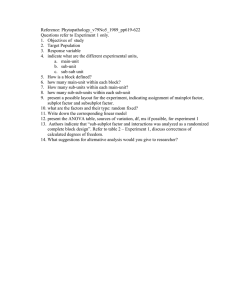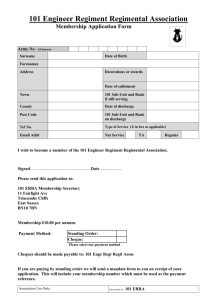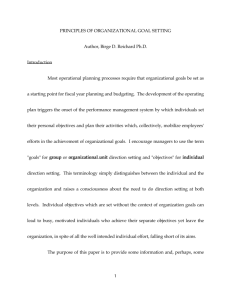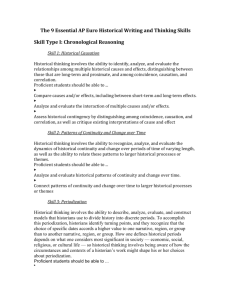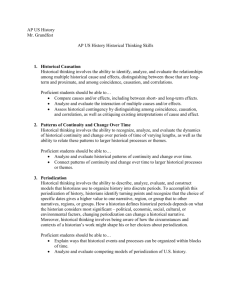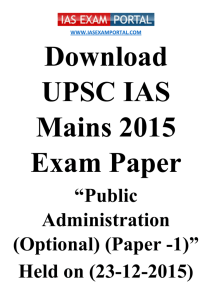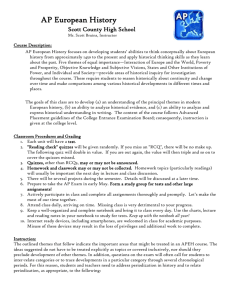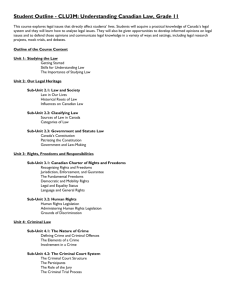AP EURO... OVERVIEW COURSE 2015
advertisement
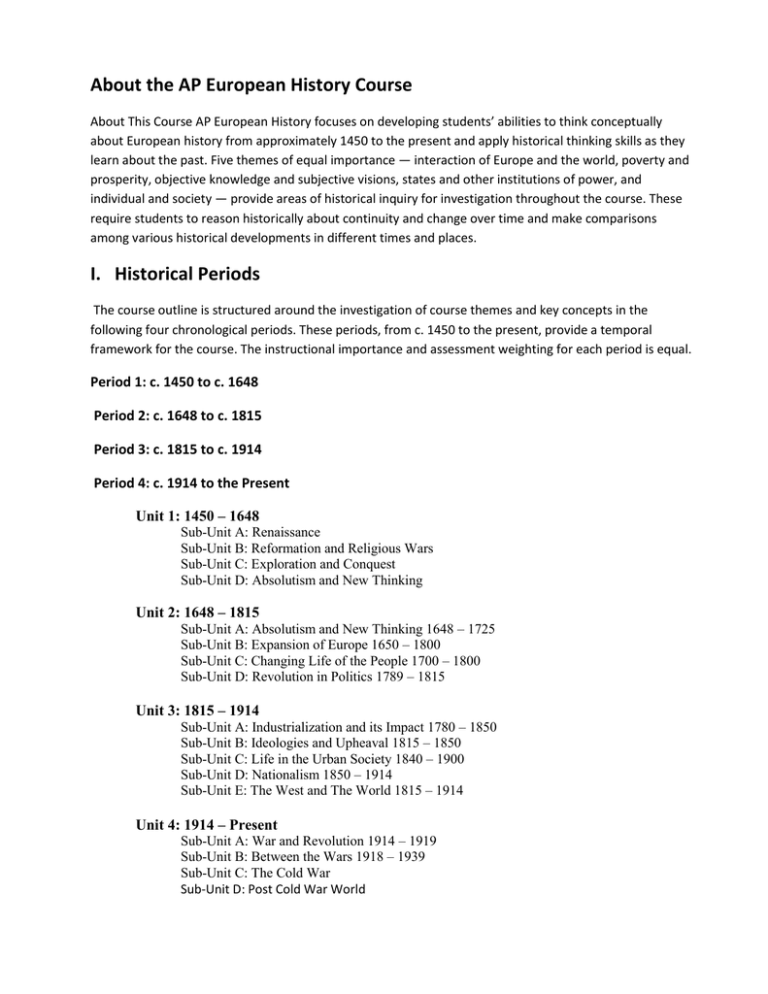
About the AP European History Course About This Course AP European History focuses on developing students’ abilities to think conceptually about European history from approximately 1450 to the present and apply historical thinking skills as they learn about the past. Five themes of equal importance — interaction of Europe and the world, poverty and prosperity, objective knowledge and subjective visions, states and other institutions of power, and individual and society — provide areas of historical inquiry for investigation throughout the course. These require students to reason historically about continuity and change over time and make comparisons among various historical developments in different times and places. I. Historical Periods The course outline is structured around the investigation of course themes and key concepts in the following four chronological periods. These periods, from c. 1450 to the present, provide a temporal framework for the course. The instructional importance and assessment weighting for each period is equal. Period 1: c. 1450 to c. 1648 Period 2: c. 1648 to c. 1815 Period 3: c. 1815 to c. 1914 Period 4: c. 1914 to the Present Unit 1: 1450 – 1648 Sub-Unit A: Renaissance Sub-Unit B: Reformation and Religious Wars Sub-Unit C: Exploration and Conquest Sub-Unit D: Absolutism and New Thinking Unit 2: 1648 – 1815 Sub-Unit A: Absolutism and New Thinking 1648 – 1725 Sub-Unit B: Expansion of Europe 1650 – 1800 Sub-Unit C: Changing Life of the People 1700 – 1800 Sub-Unit D: Revolution in Politics 1789 – 1815 Unit 3: 1815 – 1914 Sub-Unit A: Industrialization and its Impact 1780 – 1850 Sub-Unit B: Ideologies and Upheaval 1815 – 1850 Sub-Unit C: Life in the Urban Society 1840 – 1900 Sub-Unit D: Nationalism 1850 – 1914 Sub-Unit E: The West and The World 1815 – 1914 Unit 4: 1914 – Present Sub-Unit A: War and Revolution 1914 – 1919 Sub-Unit B: Between the Wars 1918 – 1939 Sub-Unit C: The Cold War Sub-Unit D: Post Cold War World Period 1: c. 1450 to c. 1648: key concepts 1.1 The worldview of European intellectuals shifted from one based on ecclesiastical and classical authority to one based primarily on inquiry and observation of the natural world. 1.2 The struggle for sovereignty within and among states resulted in varying degrees of political centralization 1.3 Religious pluralism challenged the concept of a unified Europe. 1.4 Europeans explored and settled overseas territories, encountering and interacting with indigenous populations. 1.5 European society and the experiences of everyday life were increasingly shaped by commercial and agricultural capitalism, notwithstanding the persistence of medieval social and economic structures. Period 2: c. 1648 to c. 1815: key concepts 2.1 Different models of political sovereignty affected the relationship among states and between states and individuals. 2.2 The expansion of European commerce accelerated the growth of a worldwide economic network. 2.3 The popularization and dissemination of the Scientific Revolution and the application of its methods to political, social, and ethical issues led to an increased, although not unchallenged, emphasis on reason in European culture. 2.4 The experiences of everyday life were shaped by demographic, environmental, medical, and technological changes. Period 3: c. 1815 to c. 1914: key concepts 3.1 The Industrial Revolution spread from Great Britain to the continent, where the state played a greater role in promoting industry. 3.2 The experiences of everyday life were shaped by industrialization, depending on the level of industrial development in a particular location. 3.3 The problems of industrialization provoked a range of ideological, governmental, and collective responses. 3.4 European states struggled to maintain international stability in an age of nationalism and revolutions. 3.5 A variety of motives and methods led to the intensification of European global control and increased tensions among the Great Powers. Period 4: c. 1914 to the Present: key concepts 4.1 Total war and political instability in the first half of the 20th century gave way to a polarized state order during the Cold War and eventually to efforts at transnational union 4.2 The stresses of economic collapse and total war engendered internal conflicts within European states and created conflicting conceptions of the relationship between the individual and the state, as demonstrated in the ideological battle between liberal democracy, communism, and fascism. 4.3 During the 20th century, diverse intellectual and cultural movements questioned the existence of objective knowledge, the ability of reason to arrive at truth, and the role of religion in determining moral standards. 4.4 Demographic changes, economic growth, total war, disruptions of traditional social patterns, and competing definitions of freedom and justice altered the experiences of everyday life. II. HISTORICAL THINKING SKILLS & TYPE SKILL TYPE HISTORICAL THINKING SKILL I. Chronological Reasoning 1. Historical Causation 2. Patterns of Continuity and Change over Time 3. Periodization II. Comparison and Contextualization 4. Comparison 5. Contextualization III. Crafting Historical Arguments from Historical Evidence 6. Historical Argumentation 7. Appropriate Use of Relevant Historical Evidence IV. Historical Interpretation and Synthesis 8. Interpretation 9. Synthesis Skill Type I: Chronological Reasoning Skill 1: Historical Causation Historical thinking involves the ability to identify, analyze, and evaluate the relationships among multiple historical causes and effects, distinguishing between those that are long-term and proximate, and among coincidence, causation, and correlation. Proficient students should be able to … ▶ Compare causes and/or effects, including between short-term and long-term effects . ▶ Analyze and evaluate the interaction of multiple causes and/or effects Skill 2: Patterns of Continuity and Change over Time Historical thinking involves the ability to recognize, analyze, and evaluate the dynamics of historical continuity and change over periods of time of varying length, as well as the ability to relate these patterns to larger historical processes or themes. Proficient students should be able to … ▶ Analyze and evaluate historical patterns of continuity and change over time. ▶ Connect patterns of continuity and change over time to larger historical processes or themes. . ▶ Assess historical contingency by distinguishing among coincidence, causation, and correlation, as well as critique existing interpretations of cause and effect. Skill 3: Periodization Historical thinking involves the ability to describe, analyze, evaluate, and construct models that historians use to divide history into discrete periods. To accomplish this periodization, historians identify turning points, and they recognize that the choice of specific dates accords a higher value to one narrative, region, or group than to another narrative, region, or group. How one defines depends on what one considers most significant in society — economic, social, religious, or cultural life — so historical thinking involves being aware of how the circumstances and contexts of a historian’s work might shape his or her choices about periodization. Proficient students should be able to … ▶ Explain ways that historical events and processes can be organized within blocks of time. ▶ Analyze and evaluate competing models of periodization of European history Skill Type II: Comparison and Contextualization Skill 4: Comparison Historical thinking involves the ability to describe, compare, and evaluate multiple historical developments within one society, one or more developments across or between different societies, and in various chronological and geographical contexts. It also involves the ability to identify, compare, and evaluate multiple perspectives on a given historical experience. Proficient students should be able to … ▶ Compare related historical developments and processes across place, time, and/or different societies, or within one society. ▶ Explain and evaluate multiple and differing perspectives on a given historical phenomenon. Skill Type III: Crafting Historical Arguments from Historical Evidence Skill 6: Historical Argumentation Historical thinking involves the ability to define and frame a question about the past and to address that question through the construction of an argument. A plausible and persuasive argument requires a clear, comprehensive, and analytical thesis, supported by relevant historical evidence — not simply evidence that supports a preferred or preconceived position. Additionally, argumentation involves the capacity to describe, analyze, and evaluate the arguments of others in light of available evidence. Proficient students should be able to … ▶ Analyze commonly accepted historical arguments and explain how an argument has been constructed from historical evidence. ▶ Construct convincing interpretations through analysis of disparate, relevant historical evidence. ▶ Evaluate and synthesize conflicting historical evidence to construct persuasive historical arguments. Skill 7: Appropriate Use of Relevant Historical Evidence Historical thinking involves the ability to describe and evaluate evidence about the past from diverse sources (including written documents, works of art, archaeological artifacts, oral traditions, and other primary sources), and requires paying attention to the content, authorship, purpose, format, and audience of such sources. It involves the capacity to extract useful information, make supportable inferences, and draw appropriate conclusions from historical evidence, while also noting the context in which the evidence was produced and used, recognizing its limitations and assessing the points of view it reflects. Proficient students should be able to … ▶ Analyze features of historical evidence such as audience, purpose, point of view, format, argument, limitations, and context germane to the evidence considered. ▶ Based on analysis and evaluation of historical evidence, make supportable inferences and draw appropriate conclusions. Skill Type IV: Historical Interpretation and Synthesis Skill 8: Interpretation Historical thinking involves the ability to describe, analyze, evaluate, and construct diverse interpretations of the past, and to be aware of how particular circumstances and contexts in which individual historians work and write also shape their interpretation of past events. Historical interpretation requires analyzing evidence, reasoning, contexts, and points of view found in both primary and secondary sources. Proficient students should be able to … ▶ Analyze diverse historical interpretations. ▶ Evaluate how historians’ perspectives influence their interpretations and how models of historical interpretation change over time. Skill 9: Synthesis Historical thinking involves the ability to develop meaningful and persuasive new Proficient students should be able to … ▶ Combine disparate, sometimes contradictory understandings of the past by applying all of the other historical thinking skills, by drawing appropriately on ideas and methods from different fields of inquiry or disciplines, and by creatively fusing disparate, relevant, and sometimes contradictory evidence from primary sources and secondary works. Additionally, synthesis may involve applying insights about the past to other historical contexts or circumstances, including the present. evidence from primary sources and secondary works in order to create a persuasive understanding of the past. ▶ Apply insights about the past to other historical contexts or circumstances, including the present. III. Thematic Learning Objectives The content learning objectives for the AP European History course and exam are organized under five themes, which are topics of historical inquiry to explore throughout the AP European History course. These themes focus student understanding of major historical issues and developments, helping students to recognize trends and processes that have emerged over centuries. LEARNING OBJECTIVES By THEME: CODE THEMATIC OBJECTIVE OVERARCHING QUESTIONS: 1. INT Interaction of Europe and the World ▶ Why have Europeans sought contact and interaction with other parts of the world? (INT-1 and 2) ▶ What political, technological, and intellectual developments enabled European contact and interaction with other parts of the world? (INT-3 and 4) ▶ How have encounters between Europe and the world shaped European culture, politics, and society? (INT-5, 6, 7, and 8) ▶ What impact has contact with Europe had on non-European societies? (INT-9, 10, and 11) 2. PP Poverty and Prosperity ▶ How has capitalism developed as an economic system? (PP-1, 2, 3, 4, and 5) ▶ How has the organization of society changed as a result of or in response to the development and spread of capitalism? (PP-6, 7, and 8) ▶ What were the causes and consequences of economic and social inequality? (PP-9, 10, 11, and 12) ▶ How did individuals, groups, and the state respond to economic and social inequality? (PP-13, 14, 15, and 16) 3. OS 4. SP Objective Knowledge and Subjective Visions States and Other Institutions of Power ▶ What roles have traditional sources of authority (church and classical antiquity) played in the creation and transmission of knowledge? (OS-1, 2, 3, and 4) ▶ How and why did Europeans come to rely on the scientific method and reason in place of traditional authorities? (OS-5, 6, 7, 8, and 9) ▶ How and why did Europeans come to value subjective interpretations of reality? (OS-10, 11, 12, and 13) ▶ What forms have European governments taken, and how have these changed over time? (SP-1, 2, 3, 4, 5, and 6) ▶ In what ways and why have European governments moved toward or reacted against representative and democratic principles and practices? (SP-7, 8, and 9) ▶ How did civil institutions develop apart from governments, and what impact have they had upon European states? (SP-10, 11, and 12) 5. IS Individual and Society ▶ What forms have family, class, and social groups taken in European history, and how have they changed over time? (IS-1, 2, 3, 4, and 5) ▶ How and why have tensions arisen between the individual and society over the course of European history? (IS-6, 7, and 8) ▶ How and why has the status of specific groups within society changed over time? (IS-9 and 10) The AP European History Exam Exam Description The AP European History Exam is 3 hours and 15 minutes long and includes both a 105-minute multiple-choice/short-answer section and a 90-minute free-response section. Each section is divided into two parts, as shown in the table below. Student performance on these four parts will be compiled and weighted to determine an AP Exam score. SECTION QUESTION TYPE I Part A: Multiple-choice questions Part B: Short answer questions Part A: Document based question II Part B: Long essay question NUMBER OF QUESTIONS 55 questions TIMING 4 questions 50 minutes 1 question 55 minutes II (includes a 15minute reading period) 35 minutes 1 question (chosen from a pair) 55 minutes % OF TOTAL EXAM SCORE 40% 20% 25% 15%
